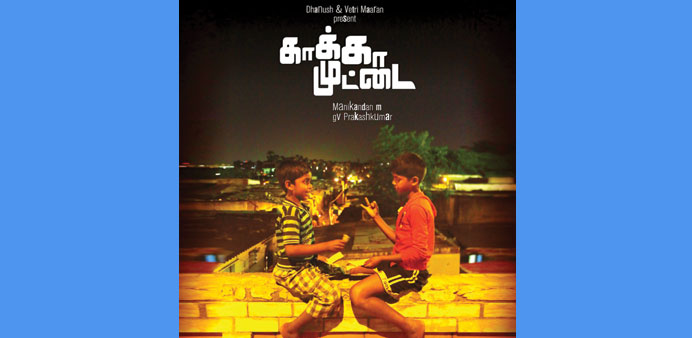By Gautaman Bhaskaran
Nobody, really nobody can imagine an India without its slums. They have been an integral part of the country’s life and living. Dharavi in Mumbai is one of the hundreds of slums in the country, and one of the biggest anywhere in the world. Spread over 535 acres and home to about a million people and a roaring manufacturing hub, Dharavi came into existence around 1882, when the British colonial masters drove factory workers out of the city centre. This slum — which ironically stands below swanky towering structures — has inspired many films.
One of the earliest that I remember was directed by Shyam Benegal and was titled Chakra, starring Smita Patil, Naseeruddin Shah and Khulbhushan Kharbanda. Poignantly presented, Chakra told the story of a woman and her son who are forced into a slum after her husband is killed. Her life with two lovers, set against this grimy backdrop and its inhabitants, was rivetingly narrated, and Chakra — which opened in 1981 — was probably one of the most authentic depictions of slum life.
And it was not before 2009 that I got to see another movie based in a slum — British auteur Danny Boyle’s Slumdog Millionaire. The film, adapted from a Vikas Swarup novel, traced the rags-to-riches story of a slum boy, played by Dev Patel — who makes his millions by winning a quiz contest. Slumdog Millionaire attracted both brickbats and bouquets. Some panned it as a cheap celebration of India’s poverty, but the Academy of Motion Picture Arts and Sciences honoured it with eight Oscars out of the 10 nods it got.
Probably inspired by Boyle’s drama, Tamil cinema is now all set to unroll several movies whose plots unfold in slums. We just saw one by Manikandan, called Kaaka Muttai. A story about two slum kids whose yearning for a pizza pushes them into exploring novel avenues of earning money, Kaaka Muttai engaged and entertained me.
Many films similarly set in slums are ready for release in the coming months. Kali Rangasami’s Oru Kuppai Kathai has choreographer Dinesh debuting as an actor. He essays a garbage collector, living with his wife (Manisha Yadav) in a kuppam or slum. I wonder whether a rag-picker has ever played a hero in a movie!
Badri Venkatesh helms Baana Kaathadi — about a young man, Ramesh, who spends his waking hours in a North Chennai slum with his school mates. They fly kites to while away their time — and it is in that kuppam that Ramesh meets a student of fashion technology. Their romance gets bumpy when he witnesses a murder.
Actor Dhanush turns a slum-dweller in Balaji Mohan’s Maari, shot in the slums of Triplicane and elsewhere in Chennai, and Kajal Aggarwal will be his screen lover. Dhanush has reportedly made a lot of effort to learn the slum lingo.
Dhanush portrays a similar part in Pudhupettai by Selvaraghavan. Tracing Kokku Kumar’s (Dhanush) life from his school days in the slums of Chennai’s Vyasarpadi and Kasimedu, the film shows us how this guy turns into a hoodlum.
Rajapandi’s Ennamo Nadakuthu is also a kuppum tale about a man who makes his living by sticking cinema posters on walls, and when he falls in love with a nurse, their romance angers the ruffians in the locality.
Undoubtedly, Tamil cinema’s courage in taking us into the slums is most laudable. For no other cinema has been bold enough to set its stories in such shabby settings. But, then, Tamil directors and producers must watch out against an over-kill. Too much of slumming can spoil the show.
Inimey Ippadithan
Muruganand’s directorial venture, Inimey Ippadithan (Hereafter, This Way), with Santhanam in the lead, did evoke a lot of expectation. The film was to be the actor’s second work as a hero, the first being the 2014’s Vallavanukku Pullum Aayudham. One had hoped that Santhanam — after years of essaying the funnyman, often as the lead star’s sidekick — would strip himself of his comic costume. This certainly did not happen in Vallavanukku Pullum Aayudham — where he was certainly testing the waters in a role which was not quite that of a hero, not quite that of a humourist either.
Unfortunately, even in Inimey Ippadithan, Santhanam appears wary of letting go of his traditional trademark mannerisms, including the way he lisps his dialogues. He hesitates to step out of the comic, with the result that he is neither here nor there.
Undoubtedly, Santhanam is a very good actor, and his dashing debonair looks can give a complex to many of those who play the lead. Probably, all he needs is a good story, an innovative script and a bit of courage to get him flying in his new avatar.
In all fairness to Santhanam, it must be admitted that Inimey Ippadithan has a poor plot, which can do little justice to any actor, however talented he be. When an astrologer warns the parents of Cheenu (Santhanam) that if he does not get married within three months, he might, well, never tie the knot, the desperate bid to find him a wife leads to hilarity and drama. While Cheenu woos Maha (Ashna Zaveri), his folks push him into an engagement with Akhila (Akhila Kishore).
Ridden with far too many clichés and done-to-death scenes, the movie slips into a hotchpotch of theatrics, songs, dances and juvenile antics. A weak script does not help a story which has little meat.
While it may be a tad too early to dismiss Santhanam as the new hero on the block, he must choose his next film with greater care.
* Gautaman Bhaskaran has been writing on Indian and world cinema for over three decades, and may be e-mailed at [email protected]

COMING SOON: The poster for Kakka Muttai.
